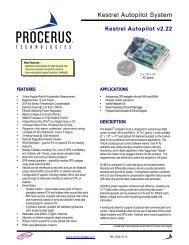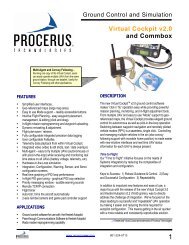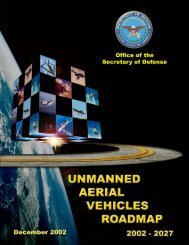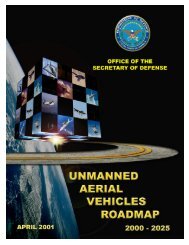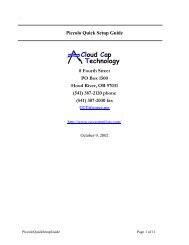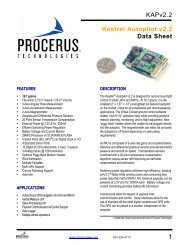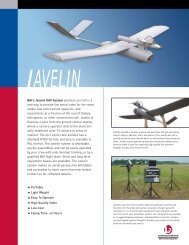JP 3-55.1 JTTP for Unmanned Aerial Vehicles - BITS
JP 3-55.1 JTTP for Unmanned Aerial Vehicles - BITS
JP 3-55.1 JTTP for Unmanned Aerial Vehicles - BITS
Create successful ePaper yourself
Turn your PDF publications into a flip-book with our unique Google optimized e-Paper software.
8. The lead agent <strong>for</strong> this publication is the US Marine Corps.9. The Joint Staff doctrine sponsor <strong>for</strong> this publication is the J-7.EnclosureFor the Chairman of the Joint Chiefs of Staff:T. R. PATRICKColonel, USASecretary, Joint Staff2
Distribution:By Secretary, Joint Staff:Joint Staff OSD NSA CIA JWC USELMNORADFEMA DISA DIA DLA DMA DNANDU MCCDC JEWC AFSC JDC DISA-JIEOCIOJWFCAdditional copies may be obtained from the Secretary, Joint Staff(Documents Division).Five copies each to: Offices of CSA, CNO, CSAF, CMC, USCGTwenty-five copies each to:USLANTCOM USCENTCOM USEUCOM FORSCOMUSPACOM USSOUTHCOM USSPACECOMUSSOCOM USSTRATCOM USTRANSCOMAdditional copies should be obtained from the Military Serviceassigned administrative support responsibility by DOD Directive5100.3, 1 November 1988, "Support of the Headquarters of Unified,Specified, and Subordinate Joint Commands."By Military Services:Army:Air Force:Navy:US Army AG Publication Center2800 Eastern BoulevardBaltimore, MD 21220-2898Air Force Publications Distribution Center2800 Eastern BoulevardBaltimore, MD 21220-2896CO, Navy Aviation Supply OfficeDistribution Division (Code 03443)5801 Tabor AvePhiladelphia, PA 19120-5000Marine Corps: Marine Corps Logistics BaseAlbany, GA 31704-5000Coast Guard:Coast Guard Headquarters, COMDT (G-REP)2100 2nd Street, SWWashington, D.C. 20593-00013
(INTENTIONALLY BLANK)4
<strong>JTTP</strong> FOR UNMANNED AERIAL VEHICLESRECORD OF CHANGESCHANGE COPY DATE OF DATE POSTEDNUMBER NUMBER CHANGE ENTERED BY REMARKS________________________________________________________________________________________________________________________________________________________________________________________________________________________________________________________________________________________________________________________________________________________________________________________________________________________________________________In accordance with the procedures contained in Joint Pub 1-01, changerecommendations to this publication will be <strong>for</strong>warded to:Urgent:TO: CG MCCDC QUANTICO VA//C427//INFO: JOINT STAFF WASHINGTON DC//J7-JDD//Routine: Operational Plans and InteroperabilityDirectorate, J-7, JDD7000 Joint Staff PentagonWashington, D.C. 20318-7000i
LIST OF EFFECTIVE PAGESThe following is a list of effective pages. Use this list to verify thecurrency and completeness of your document. An "O" indicates a page inthe original document.PAGE CHANGE PAGE CHANGEi thru vi O A-1 thru A-2 OI-1 thru 1-4 O B-1 thru B-10 OII-1 thru II-20 O GL-1 thru GL-4 Oii
JOINT TACTICS, TECHNIQUES, AND PROCEDURES FORUNMANNED AERIAL VEHICLESPREFACE1. Purpose. This publication sets <strong>for</strong>th joint tactics, techniques, andprocedures (<strong>JTTP</strong>) to govern the joint activities and per<strong>for</strong>mance of theArmed Forces of the United States in joint operations as well as thedoctrinal basis <strong>for</strong> US military involvement in multinational andinteragency operations. It provides military guidance <strong>for</strong> the exerciseof authority by combatant commanders and other joint <strong>for</strong>ce commandersand prescribes doctrine and selected tactics, techniques, and procedures<strong>for</strong> joint operations and training. It provides military guidance <strong>for</strong>use by the Armed Forces in preparing their appropriate plans. It is notthe intent of this publication to restrict the authority of the joint<strong>for</strong>ce commander (JFC) from organizing the <strong>for</strong>ce and executing themission in a manner the JFC deems most appropriate to ensure unity ofef<strong>for</strong>t in the accomplishment of the overall mission.2. Applicationa. Joint tactics, techniques, and procedures established in thispublication apply to the commanders of combatant commands, subunifiedcommands, joint task <strong>for</strong>ces, and subordinate components of thesecommands. These principles and guidance also may apply whensignificant <strong>for</strong>ces of one Service are attached to <strong>for</strong>ces of anotherService or when significant <strong>for</strong>ces of one Service support <strong>for</strong>ces ofanother Service.b. In applying the <strong>JTTP</strong> set <strong>for</strong>th in this publication, care must betaken to distinguish between distinct but related responsibilities inthe two channels of authority to <strong>for</strong>ces assigned to combatantcommands. The Military Departments and Services recruit, organize,train, equip, and provide <strong>for</strong>ces <strong>for</strong> assignment to combatant commandsand administer and support these <strong>for</strong>ces. This authority is, by law,subject to the provisions of title 10, United States Code, chapter 6,which is the section that details the authority of combatantcommanders. Commanders of the unified and specified commands exercisecombatant command (command authority) over their assigned <strong>for</strong>ces.Service component commanders are subject to the orders of combatantcommanders and, subject to the combatantiii
commander's direction, are also responsible to the MilitaryDepartments and Services in the exercise of their administrative andsupport responsibilities.c. This publication is authoritative but not directive. Commanderswill exercise judgment in applying the procedures herein to accomplishtheir missions. This <strong>JTTP</strong> should be followed except when, in thejudgment of the commander, exceptional circumstances dictateotherwise. If conflicts arise between the contents of thispublication and the contents of Service publications, this publicationwill take precedence <strong>for</strong> the activities of joint <strong>for</strong>ces unless theChairman of the Joint Chiefs of Staff, normally in coordination withthe other members of the Joint Chiefs of Staff, has provided morecurrent and specific guidance. Commanders of <strong>for</strong>ces operating as partof a multinational (alliance or coalition) military command shouldfollow multinational doctrine and procedures ratified by the US. Fordoctrine and procedures not ratified by the US, commanders shouldevaluate and follow the multinational command's doctrine andprocedures, where applicable.3. Scope. This publication provides <strong>JTTP</strong> to guide UAV operations insupport of joint operations across the operational continuum, includingroles, mission, functions and tasks; description of the threat; UAVsystem capabilities; employment considerations; C3; airspace control;and planning considerations. This discussion is in the context of theDOD-approved UAV class categories.4. Basis. Joint Pub 3-<strong>55.1</strong> is based on the sources listed in AppendixA.iv
(INTENTIONALLY BLANK)v
TABLE OF CONTENTSCHAPTERPAGEI OVERVIEW . . . . . . . . . . . . . . . . . . . . . . . . . . I-1General . . . . . . . . . . . . . . . . . . . . . . . . . . I-1UAV Class Categories . . . . . . . . . . . . . . . . . . . . I-2IIEMPLOYMENT . . . . . . . . . . . . . . . . . . . . . . . . . II-1Mission . . . . . . . . . . . . . . . . . . . . . . . . . . II-1Intelligence Requirements, Exploitation, and Dissemination . II-2Command and Control, Tasking, and Communications . . . . . . II-3Airspace Control . . . . . . . . . . . . . . . . . . . . . . II-6Planning . . . . . . . . . . . . . . . . . . . . . . . . . . II-9Conduct of the Mission . . . . . . . . . . . . . . . . . . II-15UAV System Advantages and Disadvantages . . . . . . . . . II-15Close-Range <strong>Unmanned</strong> <strong>Aerial</strong> Vehicle . . . . . . . . . . . II-16Short-Range <strong>Unmanned</strong> <strong>Aerial</strong> Vehicle . . . . . . . . . . . II-19APPENDIXA References . . . . . . . . . . . . . . . . . . . . . . . . . A-1B Users Evaluation Report . . . . . . . . . . . . . . . . . . B-1GlossaryFIGUREPart I--Abbreviations and Acronyms . . . . . . . . . . . . . GL-1Part II--Terms and Definitions . . . . . . . . . . . . . . . GL-4II-1II-2II-3II-4II-5II-6II-7UAV System Setup with Control Stations Collocated . . . II-10UAV System Setup with Control Stations at Supported Unit II-11UAV Airspace Control Measures (Overhead View) . . . . . II-12UAV Airspace Control Measures (Horizontal View) . . . . II-13US Marine Corps CR-UAV . . . . . . . . . . . . . . . . . II-17US Army Augmented System . . . . . . . . . . . . . . . . II-18SR-UAV System Description . . . . . . . . . . . . . . . II-20vi
CHAPTER IOVERVIEW1. Generala. Present reconnaissance assets available to the commander aregenerally large, costly, and usually manned, or are satellite systems.The unmanned aerial vehicle (UAV) provides an additional capability tothe commander to conduct day or night reconnaissance, surveillance,and target acquisition (RSTA), rapid battle damage assessment (BDA),and battlefield management (within line-of-sight (LOS) of the groundcontrol station (GCS)) in high-threat or heavily defended areas wherethe loss of high-value, manned systems is likely and near-real-timein<strong>for</strong>mation is required. Employment of UAVs in Vietnam and OperationDESERT STORM proved the capability of the UAV in a combat environment.UAVs require relatively few maintenance, control, and operatingpersonnel or transportation assets <strong>for</strong> deployment (versus mannedfixed-wing, helicopter, or radio units). Satellite systems arenational assets and may not be available, or it may take too long toget the in<strong>for</strong>mation from these assets to the supported commander.UAVs provide commanders with an enhanced capability to collect,disseminate, and exploit combat intelligence in<strong>for</strong>mation in near realtime.b. UAVs are significant <strong>for</strong>ce enhancers. When first introduced, theUAVs were referred to as remotely piloted vehicles (RPVs). With thedevelopment of DOD-approved class categories, the name has beenchanged to UAV. The term UAV will be used throughout thispublication.c. Future improvements promise mission area growth. The UAV alsoprovides fire support agencies an ability to target and adjustsupporting arms at significantly greater distances and at reduced riskwhen compared to current <strong>for</strong>ward observer (FO), <strong>for</strong>ward air controller(FAC), and <strong>for</strong>ward air controller (airborne) (FAC(A)) procedures. TheUAV provides near-real-time target in<strong>for</strong>mation and weapon designationcapabilities, which can reduce the risk to manned aircraft per<strong>for</strong>mingair-to-surface weapon spotting and delivery. UAV assets can be taskorganized, and UAV class categories can be selected to achieve maximumflexibility and mission success. Present mission assignments centeron the UAV's ability to per<strong>for</strong>m RSTA and BDA.I-1
2. UAV Class Categories. Presently, only one UAV system is fielded,the Pioneer system. Since the short-range UAV (SR-UAV) system will befielded in the near future, replacing the Pioneer system, the jointtactics, techniques, and procedures (<strong>JTTP</strong>) in this publication arepresented in the context of this category. Other UAV categories aredescribed in general terms to anticipate the employment of newer systemswhen they become available. The following is a description of UAV classcategories and their capabilities.a. The close-range UAV (CR-UAV) category addresses the needs of lowerlevel tactical units <strong>for</strong> a capability to investigate activities withintheir area of interest and influence. The systems in this categorywill be easy to launch, operate, and recover. They will requireminimum manpower, training, and logistics, and will be relativelyinexpensive.b. The SR-UAV category supports Army divisions, including detachedbattalion and brigade task <strong>for</strong>ces and corps, Navy and Air Forcecombatants, and Marine Air-Ground Task Forces (MAGTFs), meeting theneed to cover enemy activities out to a range of 150 kilometers ormore beyond the <strong>for</strong>ward line of own troops (FLOT) or launch plat<strong>for</strong>m(in naval operations). The UAV systems in this category are morerobust and sophisticated, can carry a wider variety of payloads, canconsist of more than one air vehicle, and per<strong>for</strong>m more kinds ofmissions than the close-range systems.c. The vertical takeoff and landing UAV (VTOL-UAV) category, <strong>for</strong>merlyreferred to as Maritime or VIPER (vertical takeoff and landingintegrated plat<strong>for</strong>m <strong>for</strong> extended reconnaissance), will be designed tocomplement the SR-UAV inventory with a VTOL-capable vehicle andprovide a low cost extension of warship sensors, enhance maritimewarfighting capabilities, thereby increasing the security of highvalue naval assets.d. The medium-range UAV (MR-UAV) category addresses the need toprovide prestrike and poststrike reconnaissance of heavily defendedtargets at significant ranges and augment manned reconnaissanceplat<strong>for</strong>ms by providing high quality, near-real-time imagery. MR-UAVsystems will differ from other UAV systems in that they will bedesigned to fly at high subsonic speeds and spend relatively smallamounts of time over target areas.I-2
e. The endurance UAV (E-UAV) category will provide high altitude,heavy payload, multimission, and surrogate satellite support acrossall mission areas with a flight duration in excess of 24 hours. E-UAVsystems will be capable of employing the widest variety of sensors andpayloads in support of joint <strong>for</strong>ces.I-3
(INTENTIONALLY BLANK)I-4
CHAPTER IIEMPLOYMENT1. Mission. The primary mission of UAV units is to support theirrespective Service component commands as a tactical RSTA systemproviding the commander a capability to gather near-real-time data onopposing <strong>for</strong>ce position, composition, and state of readiness. However,as is the case with all assets and groupings within the joint <strong>for</strong>ce, thejoint <strong>for</strong>ce commander (JFC) has full authority to assign missions to andtask component UAVs to conduct operations in support of the overalljoint <strong>for</strong>ce. When appropriately tasked, UAV units are capable ofproviding support to the JFC or other components of the joint <strong>for</strong>ce,during day and night operations on land, air, or sea. The UAVsdiscussed in this publication are nonlethal. Missions may include, butare not limited to:a. RSTA missions.b. Surveillance <strong>for</strong> search and rescue (peacetime (SAR) and combat(CSAR)).c. Deception operations.d. Maritime operations:(1) Naval surface fire support (NSFS).(2) Over-the-horizon targeting (OTH-T).(3) Ship classification.(4) Antiship missile defense (ASMD).(5) Antisubmarine warfare (ASW).(6) Search and rescue (SAR).(7) Mine defense support.e. Electronic warfare (EW) (including electronic attack (EA)),signals intelligence (SIGINT), and directed energy sensorreconnaissance.f. Nuclear, biological, and chemical (NBC) reconnaissance.II-1
g. Special and psychological operations:(1) Resupply <strong>for</strong> special operations and psychological operationsteams (scheduled and emergency).(2) Leaflet delivery and broadcast.h. Meteorology missions.i. Route and landing zone reconnaissance support.j. Adjustment of indirect fires and close air support (CAS).k. Rear area security support.l. BDA.m. Radio and data relay.2. Intelligence Requirements, Exploitation, and Disseminationa. Requirements(1) Through their RSTA collection capabilities, UAVs satisfymany intelligence requirements. Operational objectives createessential elements of in<strong>for</strong>mation (EEI) which, in turn, orientintelligence operations to support land, air, and maritimeoperations. EEIs in turn determine the payload, flight paths,and locations of RSTA activities conducted by UAVs. Intelligencerequirements, there<strong>for</strong>e, significantly influence UAV missiontasking and planning.(2) The UAV is a plat<strong>for</strong>m that can have single or multiplesensors on board. A UAV can be described as a directedcollection sensor system gathering data as programmed by theground or as a result of shared (cued) sensor data available toground control or dictated by on-board sensor data. A successfulmission is dependent on detailed geographic guidance (i.e., exactarea to be surveyed) and collection requirements (i.e., missionstatement to help determine the optimum UAV payload) from thehigher headquarters' intelligence staff.b. Exploitation. UAV product exploitation can be accomplished atvarious command levels, depending on the UAV system sophistication,the payloads used, theII-2
specific collection requirements to be satisfied, and the UAV unitexpertise. Considerations <strong>for</strong> determining who will do exploitationare:(1) Urgency between product receipt and exploitation.(2) Type and sophistication of payload used.(3) Security levels required to exploit the product.(4) Mission (BDA, etc.).(5) Dissemination channels (i.e., desired communications flowfrom the UAV payload to end user, to include any intermediateprocessing facilities).(6) Data <strong>for</strong>mat, method and rate of transmission, and type ofexploitation equipment.c. Dissemination. Dissemination is the conveyance of intelligencefrom the UAV payload to end-user, to include any intermediateprocessing facilities, in a suitable <strong>for</strong>m and timely manner.(1) Dissemination <strong>for</strong>mats include video, freeze-frame, voicecommunications, recorded message traffic, and digital data.Commonality and interoperability are the end user's primaryconcerns. Prior planning should identify types and numbers ofcommunications paths to be used, the load requirements, and thelevel of security.(2) Effective dissemination of UAV intelligence products occursthrough a coordinated ef<strong>for</strong>t by producers, consumers, anddissemination managers.3. Command and Control, Tasking, and Communicationsa. Command and Control of UAVs Supporting the Joint Force. The UAVprovides the commander the ability to per<strong>for</strong>m near-real-time RSTA todevelop and receive in<strong>for</strong>mation. However, UAV units are only designedto support a single command or component. When UAV units are taskedto support more than one command or Service component simultaneously,degradation of effectiveness can result.(1) The Services have developed and integrated UAV employmenttechniques to enhance their overall warfighting capabilities.The UAVs, their supportII-3
personnel, and GCSs will normally remain under operationalcontrol of their Service component commander.(2) The JFC has the authority to direct UAV assets <strong>for</strong> theoverall support of the joint <strong>for</strong>ce. The JFC may direct oneService component to conduct UAV operations in support of anothercomponent or task a Service component to provide UAV support tothe joint <strong>for</strong>ce or to another component on a mission-by-missionbasis. In any case, the supported commander's relationship withthe supporting UAV units should be clear. All Service componentUAV assets remain under the operational control of the Servicecomponent. When a UAV capable commander is directed to supportanother component or unit commander, the establishing authority'sdirective should include the supporting mission priority relativeto other missions. Flight control of individual UAVs is alwaysretained by the UAV unit commander.(3) UAV missions require coordinated flight planning. JFCs canestablish specific UAV flight routes and altitudes within theirrespective areas of responsibility (AORs) through their airspacecontrol authority (ACA). Prior coordination with subordinatecomponent commanders should be accomplished prior to theestablishment of joint <strong>for</strong>ce UAV flight routes and altitudes.Multiple different UAV flight routes and altitudes may beestablished <strong>for</strong> such purposes as outbound and return UAV flights.Specific UAV flight routes, established by connecting appropriateair control points, can be designated in the airspace controlplan (ACP). Specific UAV operating altitudes can also beestablished and published in the ACP. UAV flights, like mannedaircraft flights, must be coordinated to ensure deconflictionwith other airspace users, to include flights that crosscomponent boundaries. UAV missions should be coordinated withthe ACA, area air defense commander (AADC), and the JFACC. Thedetailed procedures used to deconflict UAVs and other airspaceusers are described on pages II-6 to II-13.b. Tasking(1) The JFC does not need to establish a separate and distinctrequesting process <strong>for</strong> UAV support. Requesting procedures <strong>for</strong>UAV support, from either intelligence agencies or operationalunits, should beII-4
included in the normal air request procedures of the joint <strong>for</strong>ce.Component requests <strong>for</strong> UAV support from another Service componentshould be made through the JFC. Joint Pub 3-56.24 containsexamples of air request support (AIRREQSUP) and air requestreconnaissance (AIRREQRECON) messages.(2) The UAV has both an intelligence and operationalapplication. Joint <strong>for</strong>ce procedures <strong>for</strong> resolving conflictingjoint UAV support requests should be established. ConflictingUAV missions being planned or conducted within the operationalboundaries of a particular commander should be resolved by thatcommander. Joint <strong>for</strong>ce procedures must provide <strong>for</strong> resolution ofconflicts between Service component and joint <strong>for</strong>ce requirements.Normally, the J-3 should prioritize requests and resolve anyconflicts in tasking joint <strong>for</strong>ce UAV assets.(3) These requests will be <strong>for</strong>warded to the appropriatecomponent commander with supporting UAV assets. The categoriesof missions are the same as those <strong>for</strong> normal air support--preplanned or immediate.(4) Planning <strong>for</strong> UAV missions begins when the UAV unit receivesthe tasking <strong>for</strong> UAV support. Preplanned missions may bescheduled or on call. Scheduled missions occur at a definitetime; on-call missions place the UAV on standby, awaiting launchinstructions. In either case, UAVs with predesignated payloadsare assigned <strong>for</strong> specified periods according to missionrequirements from a supported unit. UAV flights within a Servicecomponent's boundaries may be conducted without appearing ineither the joint <strong>for</strong>ce air tasking order (ATO) or specialinstructions (SPINS). However, safety of flight reference toairspace boundaries, altitudes, and times should be included inthe air control order (ACO).(5) The UAV is ideally suited <strong>for</strong> immediate missions that werenot previously anticipated because of rapidly changing tacticalsituations. As with any immediate mission, however, thesupported unit will have to take a predesignated payload that maynot be the payload of choice. Requests <strong>for</strong> immediate UAV supportare submitted by the fastest means to the joint <strong>for</strong>ce airspacecontrol agency; i.e., JAOC.II-5
c. Communications. To the greatest extent possible, existingcommunications nets should be used between the UAV unit, supportedunits, and fire support or airspace control agencies. When thetactical situation permits, the UAV unit should maintain radiocommunications with the supported command centers and airspacecoordination element throughout flight operations. However, covert orsemicovert operations in emission controlled (EMCON) conditions maypreclude use of voice communications <strong>for</strong> operations security (OPSEC)reasons. Additional working nets can be maintained with supportedunits as appropriate. Units requesting support should coordinatefrequency management of UAV uplinks and downlinks and UAV unitfrequencies if the UAV is operating in areas other than its normaloperating areas. If downlinking in<strong>for</strong>mation via the remote videoterminal (RVT) to the supported unit, the UAV unit will provide theRVT while the supported unit will normally provide the RVT operator.4. Airspace Control. Airspace control is provided to prevent mutualinterference from all users of the airspace, facilitate air defenseidentification, and accommodate and expedite the flow of all air trafficsafely. The JFC, normally through his ACA, establishes joint <strong>for</strong>ceairspace control procedures in the ACP in accordance with the guidancecontained in Joint Pub 3-52, "Doctrine <strong>for</strong> Joint Airspace Control in theCombat Zone." UAV operations must be coordinated with the ACA toprovide safe separation of UAVs and manned aircraft and to preventengagement by friendly air defense systems. The established principlesof airspace management used in manned flight operations normally applyto UAV operations but may be waived by the JFC. UAV airspacerequirements do not differ from other low per<strong>for</strong>mance aircraft. The UAVis difficult to acquire visually and does not provide a clear radarsignature presenting a potential hazard to high per<strong>for</strong>mance aircraft.To limit the hazard to fixed-winged aircraft, separation between mannedaircraft and UAVs is required. UAV missions are both preplanned andimmediate in nature. Preplanned UAV flights in support of the JFC oranother service component should be included in the joint <strong>for</strong>ce ATO,SPINS, or ACO. Immediate UAV missions will be coordinated withappropriate airspace control agencies (i.e. ASOC, DASC, AOC, TACC) toprovide safe separation between manned and unmanned aircraft and preventinadvertent engagement by friendly air defense artillery (ADA) orfighters. UAVs are launched from UAV launch and recovery sites (LRSs),which may be either airfields, unimproved field locations, or largeflight decks afloat depending on the type or size of UAV. After launch,the UAV can climb to flight route or transit altitude (normally aboveII-6
the coordination altitude) over the LRS, or climb enroute to the UAV'smission area. Once at the mission area, the UAV climbs or descends, asrequired to conduct its mission. During the UAV mission, route andaltitude changes may be required. Any changes must be coordinated withthe ACA. Upon mission completion, UAVs return to their LRS again usinga UAV flight or transit altitude. The following procedures should beused to deconflict UAVs and other airspace users:a. Restricted Operations Zones (ROZs). A ROZ should be established<strong>for</strong> a LRS and <strong>for</strong> each UAV mission area. Launch and recovery of UAVsfrom an LRS that is not located at an airfield can be facilitated byestablishing a ROZ around the LRS. The ROZ around the LRS is normallycircular, centered on the launch site, is 2 to 3 kilometers indiameter, and allows the UAV to climb and/or descend from transitaltitude over the LRS. A ROZ established <strong>for</strong> shipboard UAV operationswill con<strong>for</strong>m to the ship's normal airspace control zone. A ROZ may beestablished around the UAV's mission area to facilitate missionaccomplishment. The size and altitudes <strong>for</strong> the UAV mission area ROZis dependent on UAV capabilities and mission requirements.b. Airport Traffic Areas (ATAs) and Terminal Control Areas (TCAs).ATAs and TCAs can be used to facilitate launch and recovery of UAVs ifthe LRS is located at an airfield.c. UAV Flight Routes and Transit Altitudes. JFCs can establishspecific UAV flight routes and altitudes within their respective AORsthrough their ACA. Coordination with subordinate component commandersshould be accomplished prior to the establishment of joint <strong>for</strong>ce UAVflight routes and altitudes. Multiple UAV flight routes and altitudesmay be established <strong>for</strong> such purposes as outbound and return UAVflights. Specific UAV flight routes, established by connectingappropriate air control points, can be designated in the ACP.Specific UAV operating altitudes can also be established and publishedin the ACP. UAV flight routes can consist of a designated mean sealevel (MSL) altitude, the airspace 500 feet above and below thataltitude and approximately 1,000 feet wide. UAV flight routes aresimilar to an air corridor; however, they are normally located abovethe coordinating altitude. The LRS, air control points used, andspecific UAV mission area will normally determine the length and widthof the flight route. Although manned aircraft flight through or inUAV flight routes and altitudes is not restricted, all precautionsassociatedII-7
with visual flight rules (VFR) apply to manned aircraft operatingthrough or in them. UAV flight routes and transit altitudes areestablished and approved based on the UAV's mission and in accordancewith the ACP. Any deviation from established or approved routes andaltitudes must be coordinated with the ACA with cognizance over thatparticular airspace in question.d. Airspace Coordination Area. An airspace coordination area, arestrictive fire support coordination measure, may be used todeconflict the UAV's mission area with other airspace users.e. Route and Altitude Separation. Route and altitude separation canbe used to deconflict the UAV with other airspace users throughout theentire UAV mission. UAV routing is normally accomplished throughexisting air control points.f. Deconfliction. Any combination of the above measures can be used,as required. Deconfliction depends on the command and control (C2)function and coordination between the joint <strong>for</strong>ce components. Allaircraft working within a unit's boundaries will check in with theappropriate airspace control agency <strong>for</strong> that area upon entry and beadvised of UAV status (LRS, location of airborne UAVs, route,altitude, mission area, activation of UAV ATAs, TCAs, ROZs, ACAs,etc.) The UAV mission flight crew will change the flight route,altitude, and location of the UAV, as necessary, to deconflict withother airspace users when directed by the appropriate ACA. The flowof UAV status in<strong>for</strong>mation begins with the UAV unit responsible <strong>for</strong>launch and recovery of the UAV. Position of the UAV is constantlymonitored and controlled by the UAV mission flight crew at the UAVunit via the ground control station (GCS). UAV status is passed fromthe UAV unit to the supported unit or operational commander (via A2C2,FSCC, etc.) and appropriate airspace control agencies (ASOC, AOC,DASC, JAOC, etc.). The ACAs are responsible <strong>for</strong> relaying thisin<strong>for</strong>mation to airborne command, control, and coordination plat<strong>for</strong>ms(e.g., TAC(A), FAC(A), DASC(A), E-2C, ABCCC, AWACS, etc.). Airspacecontrol agencies and airborne command, control, and coordinationagencies areII-8
esponsible <strong>for</strong> advising all affected aircraft of UAV status uponcheck-in.5. Planning(1) Figure II-1 depicts UAV system setup with control stationscollocated.(2) Figure II-2 depicts UAV system setup with control stationsat supported unit.(3) Figure II-3 depicts UAV airspace control measures (overheadview).(4) Figure II-4 depicts UAV airspace control measures(horizontal view).a. Actual mission planning is conducted by the UAV unit, based on therequirements of the supported unit. Planning requires theconsideration of many factors such as intelligence concerning known orsuspected enemy locations, the JFC's priorities, system per<strong>for</strong>mancecapabilities, and mission payload capabilities, to select a flightpath that maximizes mission success.b. Authorities that may be involved in planning and execution includethe J-3, the JFACC, the joint targeting coordination board (JTCB), thejoint intelligence center (JIC), the ACA, the AADC, and the firesupport coordination center (FSCC). Joint <strong>for</strong>ce intelligence andnational intelligence sources can be used to cue UAV operations tospecific areas of interest throughout the operation.c. Mission planners must consider airspace management conflicts.Prior to mission planning, mission planners will send the flight routeand altitudes to the responsible airspace management or airspace C2element <strong>for</strong> initial deconfliction. They will also provide thisin<strong>for</strong>mation to the ACA and other fire support coordination and controlagencies in accordance with established joint <strong>for</strong>ce procedures.d. Mission planners must also consider any civil or politicalconstraints that may be imposed on UAV operations. Civilian orpolitically imposed restrictions may affect operations in and aroundmilitary and civilian aviation control areas and zones, in thevicinity of friendly <strong>for</strong>ces, or in the vicinity of <strong>for</strong>eign shipping.II-9
Figure II-1. UAV System Set up with Control Stations CollocatedII-10
Figure II-2. UAV System Set up with Control Stations at Supported UnitII-11
Figure II-3. UAV Airspace Control Measures (Overhead View)II-12
Figure II-4. UAV Airspace Control Measures (Horizontal View)II-13
e. The following are planning considerations <strong>for</strong> UAV missions:(1) Purpose of the mission.(2) EEI to develop missions.(3) Joint suppression of enemy air defenses (JSEAD).(4) EW.(5) Threat in the target area.(6) Route weather, especially in the target area.(7) Coordination with other friendly operations in the targetarea.(8) Data links and frequencies required by supported unit toreceive UAV signals.(9) Launch and recovery times and location.(10) Coordination of the transit route and flight path tominimize UAV vulnerability and maximize expected value of themission.(11) Synchronization with other airspace users.(12) Request <strong>for</strong> coordination or provision of assets to analyzethe in<strong>for</strong>mation beyond UAV unit capability, as required.(13) Requested system per<strong>for</strong>mance capabilities. Shorter rangesystems may require the relocation of support personnel andground equipment. If the requesting unit does not know the exactcapabilities needed, it should provide the tasking agency withthe most complete list of mission requirements possible.(14) Security <strong>for</strong> the UAV units if they are required to moveinto the supported unit's boundary.(15) Support of UAV unit. If the UAV unit is notself-supporting, it must coordinate with the supported unit <strong>for</strong>required logistic support, such as materials handling equipment(MHE), fuel and packaged petroleum, oils, and lubricants (POL)and surface and/or air transportation.II-14
6. Conduct of the Mission. UAVs can be manually controlled orpreprogrammed to fly autonomous missions. Most UAV operations requiremanual launch and recovery. For multi-UAV operations, one UAV may beput in the preprogrammed mode to fly a specified course or to circle adesignated target area while an additional UAV is launched and manuallycontrolled.a. Manual Control. After launch, the UAV climbs to a predeterminedaltitude under autopilot or manual control of the internal pilot atthe GCS. The mission commander ensures that the UAV adheres to theplanned mission. The supported unit will coordinate with theappropriate agencies <strong>for</strong> any changes it directs. UAV positions willbe maintained and, when necessary, reported to appropriate airspacecontrol agencies. Upon conclusion of the mission, the UAV returns viadesignated control points to the recovery area.b. Preprogrammed or Autonomous Control. The preprogrammed modeallows the UAV to proceed on a preselected course and per<strong>for</strong>mspecified patterns during loiter such as an orbit in a selected areawhere it could be placed under real-time control of an airborne orshipborne control station or as a countermeasure to hostile EW. TheUAV will be monitored by the GCS to ensure it maintains the programmedaltitude and position. After mission completion, the UAV proceeds viaprogrammed points toward a location where there is manual control <strong>for</strong>terminal approach and landing. One special feature of all UAVmissions is a preprogrammed emergency flight mode called "returnhome." The sequence <strong>for</strong> return home is as follows: if data link islost, the UAV automatically flies to a selected altitude and locationand holds. When command is reestablished, the UAV continues themission as planned. If command signals are not reestablished, the UAVwill continue holding until running out of fuel. Each flight includesplanning <strong>for</strong> a remote recovery checkpoint located so that acquisitionof the UAV by a control station is enhanced if return home isinitiated.7. UAV System Advantages and Disadvantagesa. Advantages. UAV systems gather combat in<strong>for</strong>mation in real or nearreal time and transmit it to their ground stations by data link day ornight. This capability reduces the need <strong>for</strong> manned aircraft tooverfly enemy territory. Transportation and logistic requirements todeploy the UAV systems are usually smaller than other airborneintelligence collection resources. Current UAVII-15
systems are fairly interoperable between the Services and extensivespecial training is not required to use much of the in<strong>for</strong>mationprovided by UAVs. Further, UAV systems are designed to interface withother intelligence systems such as the all-source analysis system(ASAS) and Joint Surveillance Target Attack Radar System (JointSTARS).b. Disadvantages. The two primary UAV disadvantages includeenvironmental restrictions to flight and the requirement <strong>for</strong> LOSbetween the UAV and the controlling or relay stations (ground,airborne, or shipborne) processing the aircraft or payload. Futurecapabilities <strong>for</strong> off-tether operations may eventually redress thislatter disadvantage.8. Close-Range <strong>Unmanned</strong> <strong>Aerial</strong> Vehicle. The CR-UAV system is composedof a baseline system (US Marine Corps) and an augmented system (US Army,using the baseline system as a launch and recovery unit) as depicted inFigures II-5 and II-6.a. Advantages. CR-UAV has extremely small transportationrequirements when compared to other UAV systems or to reconnaissance(RECCE) units that employ electronic equipment. It can be effectivelyoperated from small clearings, parking lots, or compounds. The UAV'ssmall visual and radar signatures enhance its survivability. CR-UAVis relatively simple to operate, requires few dedicated personnel, andallows resident military specialties, such as <strong>for</strong>ward observer orintelligence analyst, to be integrated easily. This feature increasesthe operational flexibility of the CR-UAV system. The ground controlunit design allows <strong>for</strong> automatic or mechanical interface with otherDOD systems such as the all-source analysis system (ASAS) and theground station module (GSM).b. Disadvantages. The reduced size and limited endurance of theCR-UAV requires repetitive launches to maintain surveillance <strong>for</strong>extended periods. The operating range of the UAV is approximately 50kilometers; there<strong>for</strong>e, operational site selection options may belimited. The UAV's small size (200 pounds or less) means thatminiaturization is required be<strong>for</strong>e multiple payloads that per<strong>for</strong>mseveral missions can be carried on one flight. The small size of theGCS necessitates support from other sources <strong>for</strong> complete analysis ofpayload products.II-16
Figure II-5. US Marine Corps CR-UAVII-17
Figure II-6. US Army Augmented System(USMC system in shaded area)II-18
9. Short-Range <strong>Unmanned</strong> <strong>Aerial</strong> Vehicle. The SR-UAV is composed of abaseline system (Figure II-7) that can be adjusted by the addition orremoval of personnel and equipment to meet operational needs. Thebaseline system consists of an mission planning station (MPS), GCS, airvehicles (AVs), payloads, an LRS, and RVTs. Present SR-UAV payloadprovides a day or night imagery intelligence (IMINT) capability inaddition to radio relay. A variety of additional multiple missionpayloads are planned as system growth improvements.a. Advantages. The SR-UAV's increased range and endurance allows <strong>for</strong>the system to operate over a significant area. Payload capacityallows <strong>for</strong> the UAV to carry multiple payloads, executing severalmissions on a given flight. The ability to analyze the payloadproduct is resident within the system ground or ship componentequipment. During preprogrammed autonomous flight, several hours ofdata can be recorded and stored on board the UAV and then retrievedand interpreted after UAV recovery. The UAV may also maintain aconstant link with GCS to provide real-time coverage, albeit atreduced ranges. RVTs can be supplied to provide downlink in<strong>for</strong>mationduring mission execution to selected agencies such as the commandcenters or joint intelligence centers.b. Disadvantages. The SR-UAV unit requires significanttransportation, personnel, and logistic support. Depending onconfiguration, three to eight C-141 load equivalents will be needed todeploy the SR-UAV unit. This is not a consideration <strong>for</strong> the Navy SRsystem which deploys with the host ship. The UAV size necessitatesground and shipboard handling considerations which limits theopportunity to operate from small clearings or unprepared areas andcan impact routine afloat flight operations without prior flight planintegration. The present SR-UAV has engines that operate on gas fuelthat is not available through DOD logistic systems, but future blockupgrades may include engines that run on available fuel.II-19
Figure II-7. SR-UAV System DescriptionII-20
(INTENTIONALLY BLANK)II-21
APPENDIX AREFERENCES1. DOD Publication. DOD UAV Master Plan, 1992.2. Joint Publicationsa. Joint Pub 0-2, 1 December 1986, "Unified Action Armed Forces(UNAAF)."b. Joint Pub 1-01, 30 July 1992, "Joint Publication System."c. Joint Pub 1-02, 1 December 1989, "DOD Dictionary of Military andAssociated Terms."d. Joint Pub 2-0, (in development), "Joint Doctrine <strong>for</strong> IntelligenceSupport to Joint Operations."e. Joint Pub 3-02, 8 October 1992, "Joint Doctrine <strong>for</strong> AmphibiousOperations."f. Joint Pub 3-02.1, (in development), "Joint Doctrine <strong>for</strong> LandingForce Operations."g. Joint 3-52, (in development), "Doctrine <strong>for</strong> Joint Airspace Controlin the Combat Zone."h. Joint Pub 3-55, 14 April 1993, "Doctrine <strong>for</strong> Joint Reconnaissance,Surveillance, and Target Acquisition (RSTA)."i. Joint Pub 3-56.24, 1 October 1991, "Tactical Command and ControlPlanning Guidance and Procedures <strong>for</strong> Joint Operations Joint InterfaceOperational Procedures - Message Text Formats."3. Service Publicationsa. FM 1-103, 30 December 1981, "Airspace Management and Air TrafficControl in a Combat Zone."b. FM 6-20, 17 May 1988, "Fire Support in the Airland Battle."c. FM 30-60A, 6 June 1989, "Counterintelligence Operations."A-1
d. FM 34-1, 2 July 1987, "Intelligence and Electronic WarfareOperations."e. FM 34-37, 15 January 1991, "Echelons Above Corps Intelligence andElectronic Warfare Operations."f. FM 100-15, 13 September 1989, "Corps Operations."g. FM 100-42, 1 December 1976, "US Air Force/US Army AirspaceManagement in Area of Operations."h. FM 100-103, 7 October 1987, "Army Airspace Command and Control ina Combat Zone."i. FMFM 3-21, 1 May 1991, "MAGTF Intelligence Operations."j. FMFM 3-22, "Surveillance, Reconnaissance, Intelligence Group(SRIG)." (under development)k. FMFM 3-22-1, "UAV Company Operations." (under development)l. FMFM 5-60, 22 June 1993, "Control of Aircraft and Missiles."m. FMFM 6-18, 1 March 1992, "Techniques and Procedures <strong>for</strong> FireSupport Coordination."n. FMFM 2-7, 1 September 1991, "Fire Support in Marine Air GroundTask Force Operations."o. ATP-26, "Air Reconnaissance Intelligence Reporting Nomenclature."p. ATP-44, "Electronic Warfare (EW) in Air Operations."q. ATP-51, "Electronic Warfare in the Land Battle."r. NWP 22-2/FM 1-7, 1 June 1990, "Supporting Arms in AmphibiousOperations."s. Concept of Operations <strong>for</strong> Medium Range <strong>Unmanned</strong> <strong>Aerial</strong> <strong>Vehicles</strong>,11 June 1991.A-2
(INTENTIONALLY BLANK)A-3
APPENDIX BUSERS EVALUATION REPORTON JOINT PUB 3-<strong>55.1</strong>1. Users in the field are highly encouraged to submit comments onthis pub by removing this page and sending it to JDC. Please fill outthe following: users' POC, unit address, and phone (DSN) number.2. Contenta. Does the pub provide a conceptual framework <strong>for</strong> the topic?b. Is the in<strong>for</strong>mation provided accurate? What needs to be updated?c. Is the in<strong>for</strong>mation provided useful? If not, how can it beimproved?d. Is this pub consistent with other joint pubs?B-1
e. Can this pub be better organized <strong>for</strong> the best understanding of thedoctrine and/or <strong>JTTP</strong>? How?3. Writing and Appearancea. Where does the pub need some revision to make the writing clearand concise? What words would you use?b. Are the charts and figures clear and understandable? How wouldyou revise them?4. Recommended urgent change(s) (if any).5. Other6. Please fold and mail comments to the Joint Doctrine Center(additional pages may be attached if desired) or FAX to DSN 564-3990 orCOMM (804) 444-3990.B-2
(FOLD)--------------------------------------------------------------FROM:JOINT DOCTRINE CENTERBLDG R-521283 CV TOWWAY STE 100NORFOLK VA 23511-2491--------------------------------------------------------------(FOLD)B-3
APPENDIX BUSERS EVALUATION REPORTON JOINT PUB 3-<strong>55.1</strong>1. Users in the field are highly encouraged to submit comments onthis pub by removing this page and sending it to JDC. Please fill outthe following: users' POC, unit address, and phone (DSN) number.2. Contenta. Does the pub provide a conceptual framework <strong>for</strong> the topic?b. Is the in<strong>for</strong>mation provided accurate? What needs to be updated?c. Is the in<strong>for</strong>mation provided useful? If not, how can it beimproved?d. Is this pub consistent with other joint pubs?B-4
e. Can this pub be better organized <strong>for</strong> the best understanding of thedoctrine and/or <strong>JTTP</strong>? How?3. Writing and Appearancea. Where does the pub need some revision to make the writing clearand concise? What words would you use?b. Are the charts and figures clear and understandable? How wouldyou revise them?4. Recommended urgent change(s) (if any).5. Other6. Please fold and mail comments to the Joint Doctrine Center(additional pages may be attached if desired) or FAX to DSN 564-3990 orCOMM (804) 444-3990.B-5
(FOLD)--------------------------------------------------------------FROM:JOINT DOCTRINE CENTERBLDG R-521283 CV TOWWAY STE 100NORFOLK VA 23511-2491--------------------------------------------------------------(FOLD)B-6
APPENDIX BUSERS EVALUATION REPORTON JOINT PUB 3-<strong>55.1</strong>1. Users in the field are highly encouraged to submit comments onthis pub by removing this page and sending it to JDC. Please fill outthe following: users' POC, unit address, and phone (DSN) number.2. Contenta. Does the pub provide a conceptual framework <strong>for</strong> the topic?b. Is the in<strong>for</strong>mation provided accurate? What needs to be updated?c. Is the in<strong>for</strong>mation provided useful? If not, how can it beimproved?d. Is this pub consistent with other joint pubs?B-7
e. Can this pub be better organized <strong>for</strong> the best understanding of thedoctrine and/or <strong>JTTP</strong>? How?3. Writing and Appearancea. Where does the pub need some revision to make the writing clearand concise? What words would you use?b. Are the charts and figures clear and understandable? How wouldyou revise them?4. Recommended urgent change(s) (if any).5. Other6. Please fold and mail comments to the Joint Doctrine Center(additional pages may be attached if desired) or FAX to DSN 564-3990 orCOMM (804) 444-3990.B-8
(FOLD)--------------------------------------------------------------FROM:JOINT DOCTRINE CENTERBLDG R-521283 CV TOWWAY STE 100NORFOLK VA 23511-2491--------------------------------------------------------------(FOLD)B-9
APPENDIX BUSERS EVALUATION REPORTON JOINT PUB 3-<strong>55.1</strong>1. Users in the field are highly encouraged to submit comments onthis pub by removing this page and sending it to JDC. Please fill outthe following: users' POC, unit address, and phone (DSN) number.2. Contenta. Does the pub provide a conceptual framework <strong>for</strong> the topic?b. Is the in<strong>for</strong>mation provided accurate? What needs to be updated?c. Is the in<strong>for</strong>mation provided useful? If not, how can it beimproved?d. Is this pub consistent with other joint pubs?B-10
e. Can this pub be better organized <strong>for</strong> the best understanding of thedoctrine and/or <strong>JTTP</strong>? How?3. Writing and Appearancea. Where does the pub need some revision to make the writing clearand concise? What words would you use?b. Are the charts and figures clear and understandable? How wouldyou revise them?4. Recommended urgent change(s) (if any).5. Other6. Please fold and mail comments to the Joint Doctrine Center(additional pages may be attached if desired) or FAX to DSN 564-3990 orCOMM (804) 444-3990.B-11
(FOLD)--------------------------------------------------------------FROM:JOINT DOCTRINE CENTERBLDG R-521283 CV TOWWAY STE 100NORFOLK VA 23511-2491--------------------------------------------------------------(FOLD)B-12
APPENDIX BUSERS EVALUATION REPORTON JOINT PUB 3-<strong>55.1</strong>1. Users in the field are highly encouraged to submit comments onthis pub by removing this page and sending it to JDC. Please fill outthe following: users' POC, unit address, and phone (DSN) number.2. Contenta. Does the pub provide a conceptual framework <strong>for</strong> the topic?b. Is the in<strong>for</strong>mation provided accurate? What needs to be updated?c. Is the in<strong>for</strong>mation provided useful? If not, how can it beimproved?d. Is this pub consistent with other joint pubs?B-13
e. Can this pub be better organized <strong>for</strong> the best understanding of thedoctrine and/or <strong>JTTP</strong>? How?3. Writing and Appearancea. Where does the pub need some revision to make the writing clearand concise? What words would you use?b. Are the charts and figures clear and understandable? How wouldyou revise them?4. Recommended urgent change(s) (if any).5. Other6. Please fold and mail comments to the Joint Doctrine Center(additional pages may be attached if desired) or FAX to DSN 564-3990 orCOMM (804) 444-3990.B-14
(FOLD)--------------------------------------------------------------FROM:JOINT DOCTRINE CENTERBLDG R-521283 CV TOWWAY STE 100NORFOLK VA 23511-2491--------------------------------------------------------------(FOLD)B-15
GLOSSARYPART IABBREVIATIONS AND ACRONYMSAADCA2C2ABCCCACAACOACPADAADRAIRREQRECONAIRREQSUPAOCAORASASASMDASOCASWATAATOAVAWACSBDAC2CASCOCCPCR-UAVCSARDASCDASC(A)DODEAEEIEMCONE-UAVEWarea air defense commanderArmy airspace command and controlairborne command, control, and communicationsairspace control authorityairspace control orderairspace control planair defense artilleryair data relayair request reconnaissanceair request supportair operations centerarea of responsibilityall-source analysis systemantiship missile defenseair support operations centerantisubmarine warfareairport traffic areaair tasking orderair vehicleairborne warning and control systembattle damage assessmentcommand and controlclose air supportcombat operations centercontrol pointclose range unmanned aerial vehiclecombat search and rescuedirect air support centerdirect air support center (airborne)Department of Defenseelectronic attackessential element of in<strong>for</strong>mationemission controlendurance unmanned aerial vehicleelectronic warfareGL-1
FACFAC(A)FLOTFOFSCCGCSGDTGSEGSMHMMWVIMINTJAOCJFACCJFCJICJSEADJSTARSJTCB<strong>JTTP</strong>LOSLRSMAGTFMHEMMPMPSMR-UAVMSLNBCNSFSOPSECOTH-TPOLRECCEROZRPVRSTARVT<strong>for</strong>ward air controller<strong>for</strong>ward air controller (airborne)<strong>for</strong>ward line of own troops<strong>for</strong>ward observerfire support coordination centerground control stationground data terminalground support equipmentground station modulehigh mobility multipurpose wheeled vehicleimagery intelligencejoint air operations centerjoint <strong>for</strong>ce air component commanderjoint <strong>for</strong>ce commanderjoint intelligence centerJoint suppression of enemy air defensesjoint surveillance target attack radar systemjoint targeting coordination boardjoint tactics, techniques, and proceduresline-of-sightlaunch and recovery siteMarine Air-Ground Task Forcematerials handling equipmentmodular mission payloadsmission planning stationmedium-range unmanned aerial vehiclemean sea levelnuclear, biological, and chemicalnaval surface fire supportoperations securityover-the-horizon targetingpetroleum, oils, and lubricantsreconnaissancerestricted operations zoneremotely piloted vehiclereconnaissance, surveillance, and target acquisitionremote video terminalGL-2
SARSIGINTSINCGARSSPINSSR-UAVTAC(A)TACCTCAsearch and rescuesignals intelligencesingle channel ground and airborne radio systemspecial instructionsshort-range unmanned aerial vehicletactical air commander (airborne)Tactical Air Control Centerterminal control areaUAVunmanned aerial vehicleUNAAF Unified Action Armed Forces (Joint Pub 0-2)VFRVIPERVTOLVTOL-UAVvisual flight rulesvertical takeoff and landing integrated plat<strong>for</strong>m <strong>for</strong>extended reconnaissancevertical takeoff and landingvertical takeoff and landing unmanned aerial vehicleGL-3
PART IITERMS AND DEFINITIONSdirect support. A mission requiring a <strong>for</strong>ce to support another specific<strong>for</strong>ce and authorizing it to answer directly the supported <strong>for</strong>ce'srequest <strong>for</strong> assistance. (Joint Pub 1-02)general support. That support which is given to the supported <strong>for</strong>ce asa whole and not to any particular subdivision thereof. (Joint Pub 1-02)joint <strong>for</strong>ce commander. A general term applied to a commander authorizedto exercise Combatant Command (command authority) or operational controlover a joint <strong>for</strong>ce. Also called JFC. (Joint Pub 1-02)near real time. Pertaining to the timeliness of data or in<strong>for</strong>mationwhich has been delayed by the time required <strong>for</strong> electronic communicationand automatic data processing. This implies that there are nosignificant delays. (Joint Pub 1-02)unmanned aerial vehicle.** A powered, aerial vehicle that does notcarry a human operator, uses aerodynamic <strong>for</strong>ces to provide vehicle lift,can fly autonomously or be piloted remotely, can be expendable orrecoverable, and can carry a lethal or nonlethal payload. Ballistic orsemiballistic vehicles, cruise missiles, and artillery projectiles arenot considered unmanned aerial vehicles. Also called UAV.** Upon approval of this publication, this term and definition willbe included in Joint Pub 1-02.GL-4
(INTENTIONALLY BLANK)GL-5
GL-6



